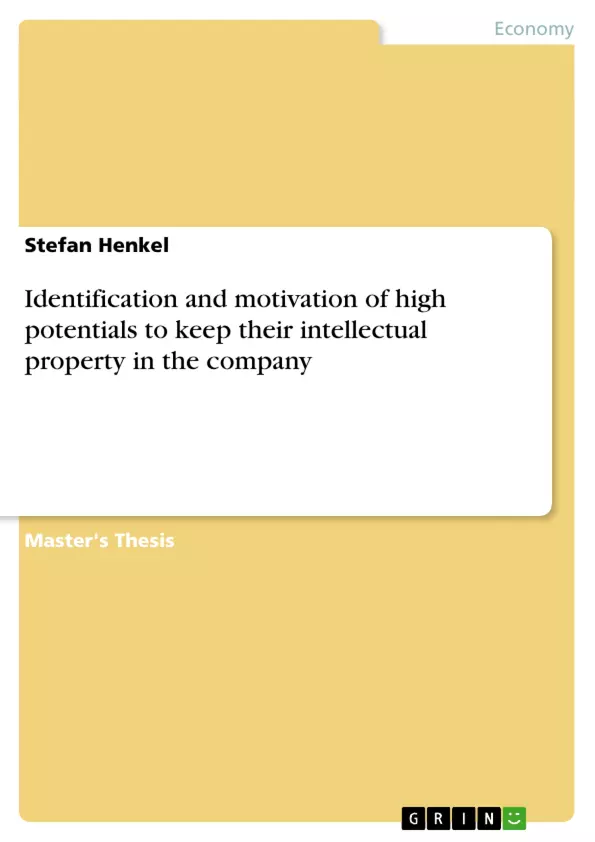21 percent of employees have no emotional attachment to the employer, 66 percent will be the
call of duty. The figures have almost doubled since 2001.
To counteract this trend, it is important to identify and motivate high potentials to retain them
in the company. This primarily concerns the highly dedicated staff, but also the tacit
knowledge of the employees that is not explicitly written down.
The author chooses the following title for his Master-Thesis, to take up this subject of
economic scientific: Identification and motivation of high potentials to keep their intellectual
property in the company.
On this occasion, it is started in the introduction to the subject and the problem is explained,
the objectives of the Master-Thesis are presented and it will set a demarcation issue.
Then it is shown how a simple method can identify high potentials.
Chapter 3 describes the proper motivation of A-staff. This chapter includes case study.
The following chapter is about keeping the previously identified employees in the company in
order to exploit the existing potential. The top 10 employee retention tools are presented
therein. This topic will also be completed by a case study.
A final conclusion collects all the previously mentioned points and ventures a prognosis for
the future.
Appropriate literature used to work on this Master-Thesis is present. A corresponding list of
references can be found in section IV: Bibliography.
The author chose the above topic, as it is becoming increasingly difficult in the future, to find,
identify and motivate good employees, to keep them in one’s own company. The demand for high potentials is unimaginably high. In the end, it is in the interest of the company itself, not
to lose the high potentials.
Therefore there is always the same principle: “Companies are only as good as their
employees”. So it should be a prioritized ambition for every company, to employ and retain
the best of the high potentials.[...]
Inhaltsverzeichnis (Table of Contents)
- 1 INTRODUCTION
- 1.1 INTRODUCTION TO THE TOPIC AND PROBLEM STATEMENT
- 1.2 OBJECTIVES OF THE MASTER THESIS
- 1.3 TOPIC DEMARCATION
- 2 IDENTIFIACATION OF HIGH POTENTIALS
- 2.1 SYSTEMATIC IDENTIFICATION OF HIGH POTENTIALS
- 2.1.1 ABC APPROACH TO EMPLOYEE CLASSIFICATION
- 2.1.2 EXAMPLES OF BEHAVIOR, PERSONALITY TRAITS AND SOCIAL SKILLS OF DIFFERENT EMPLOYEE GROUPS
- 2.2 IMPORTANCE OF APPRAISAL INTERVIEWS
- 2.3 MANAGEMENT BY OBJECTIVES
- 3 MOTIVATION OF HIGH POTENTIALS
- 3.1 HOW MOTIVATION WORKS
- 3.2 EMPLOYER BRAND
- 3.3 OVERLOAD AND BURNOUT
- 3.4 EXECUTIVES AS ENERGY MANAGER
- 3.5 THE LAW OF SERENITY
- 3.6 CASE STUDY ‘HOW TO INCREASE THE MOTIVATION OF HIGH POTENTIALS’
- 4 KEEP THE INTELLECTUAL PROPERTY OF HIGH POTENTIALS IN THE COMPANY
- 4.1 EMPLOYEE RETENTION
- 4.2 TOP 10 RETENTION INSTRUMENTS
- 4.2.1 OPPORTUNITIES FOR ADVANCEMENT AND DEVELOPMENT
- 4.2.2 PROFESSIONAL TRAININGS
- 4.2.3 RESPONSIBILITY SCOPES
- 4.2.4 RECOGNITION AND APPRECIATION OF JOB PERFORMANCE
- 4.2.5 OPPORTUNITIES TO CO-DECIDE AND PARTICIPATION
- 4.2.6 PERFORMANCE ORIENTED PAYMENT
- 4.2.7 WORK LIFE BALANCE
- 4.2.8 EXCELLENT WORKING ATMOSPHERE AND ENVIRONMENT
- 4.2.9 INTERNAL COMMUNICATION
- 4.2.10 HONESTY AND CREDIBILITY OF THE COMPANY
- 4.3 CASE STUDY ‘HOW TO KEEP INTELLECTUAL PROPERTY IN THE COMPANY’
- 5 CONCLUSION
Zielsetzung und Themenschwerpunkte (Objectives and Key Themes)
The main objective of this Master-Thesis is to show how important it is to have an integral recruitment process. It focuses on identifying, developing, and retaining high potential employees, emphasizing the crucial role they play in a company's success. Key themes explored in this thesis include:- Identifying and classifying employees into distinct groups based on their performance and potential
- Understanding the intricacies of intrinsic and extrinsic motivation and its impact on employee performance
- The importance of establishing a positive employer brand and fostering a healthy working environment to retain high potential employees
- Implementing effective employee retention strategies and tools to maintain the intellectual property of key employees
Zusammenfassung der Kapitel (Chapter Summaries)
Chapter 1: Introduction
This chapter introduces the topic of identifying and motivating high potentials to keep their intellectual property within the company. It highlights the challenges companies face with employee turnover, particularly the loss of highly skilled employees and their valuable knowledge. The chapter sets out the objectives of the Master-Thesis, aiming to explore effective strategies for retaining high potentials through a holistic approach.Chapter 2: Identification of High Potentials
This chapter delves into methods for systematically identifying high potentials. The ABC approach, a classification system based on employee performance and potential, is presented and discussed. Additionally, the importance of appraisal interviews and management by objectives as tools for identifying and developing high potentials is highlighted.Chapter 3: Motivation of High Potentials
This chapter explores the concept of motivation, distinguishing between intrinsic and extrinsic motivation. It discusses various theories of motivation, including Maslow's hierarchy of needs and Herzberg's two-factor theory. The chapter also examines the impact of employer branding, employee burnout, and the importance of managers as "energy managers" in motivating their teams.Chapter 4: Keeping the Intellectual Property of High Potentials in the Company
This chapter focuses on employee retention strategies. It examines the psychological and organizational factors that influence employee loyalty and commitment. The chapter also presents a list of top 10 retention instruments used by leading companies, including opportunities for advancement, professional training, and work-life balance initiatives. This chapter concludes with a case study that demonstrates how to implement a comprehensive retention management program.Schlüsselwörter (Keywords)
This Master-Thesis focuses on the identification, motivation, and retention of high potential employees. The core concepts explored include: employee classification, intrinsic and extrinsic motivation, employer branding, burnout prevention, employee retention strategies, top retention instruments, and intellectual property protection. The work emphasizes the importance of a holistic approach to talent management, combining employee development, performance management, and retention initiatives.- Citar trabajo
- MBA Stefan Henkel (Autor), 2013, Identification and motivation of high potentials to keep their intellectual property in the company, Múnich, GRIN Verlag, https://www.grin.com/document/215483



